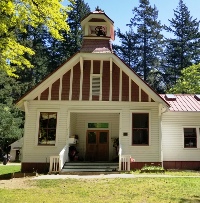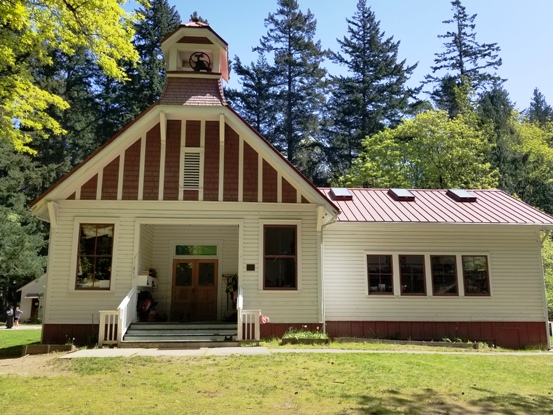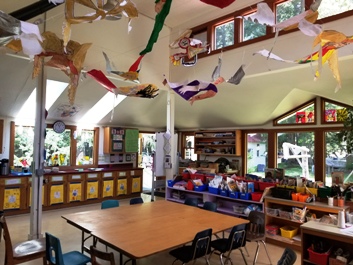–by Matthew Gilbert, Orcas Issues reporter, Corrected May 2 at 8 a.m.–
The Orcas Island School District (OISD) Board held its annual Waldron Island School meeting, chaired by Greg White, the morning of Thursday April 26. Waldron is part of the school district’s “rural, distant” classification. The board held its regular, monthly meeting later the same day at the Orcas school library.
The Waldron trip was especially meaningful to the OISD Board’s three new members, Diane Boerstler, John Fleming, and Josh Culp, who were making their first trip to our off-the-grid neighbor. All were impressed with the quality of education the island’s eight students were getting and the innovative approaches used.
“The way they’re learning is absolutely brilliant,” said Boerstler. “All subjects are integrated by topic; in this case history, math, English, social studies, science, the arts, and the building all centered around Medieval times. Students from Kindergarten up masterfully presented a holistic view on the topic, confidently explaining what they’ve learned and why it’s important. You can tell the teachers care and go the extra 100 miles to integrate knowledge and fun at the same time. I think every school in America, including the 30+ I’ve worked at, could take a cue from their project-based approach.”
“What struck me the most,” said Culp, “was the natural light that radiated out of the school, both figuratively on the faces of the children, staff, and parents and from the purely natural sunlight illuminating the school.”
As Waldron lead teacher Isa Delahunt concluded in her written report, “Having done medievalism to death and then some, we are now leaping into the twenty-first century to get in our final science unit of the year, on renewable energy. From swords to solar panels . . .”
Back on Orcas, the afternoon board meeting began with a report by Martha Inch, representing the Orcas Education Association. Inch is a Science Fellow, a member of the Curriculum Support Team, and a National Board-Certified Teacher. She discussed the adoption of Next Generation Science Standards (NGSS) into the general science curriculum, where the emphasis “is not on content but on using content to solve problems.” With this new approach, she explained, students are learning to “figure out” things, not “learn about” them.
Elyn Anderson and Lorena Stankevich then gave an update on the district’s “Highly Capable Program,” which has been providing accelerated learning opportunities to eligible students in grades 1 – 5. Anderson emphasized that the program doesn’t just target the most gifted students but those they feel would “benefit the most” from it. There are currently 13 students participating, with more on the way. The program is now well-enough established that team leaders are starting to look ahead at how it can be improved as well as extended into middle school and beyond, said Anderson.
A report on the OISD’s Capital Improvements plan, financed by a $10.8M bond passed last November, was introduced by Program Manager Liz LeRoy. She got the conversation going by noting that the project team had been meeting with multiple groups over the last few months and that “the budget is tight, and we’re being careful.” She then introduced David Mount of Mahlum Architects, whose firm is doing the design and spec work. Mount emphasized that what he was about to present was “still very much in the beginning phases,” but enough progress had been made that he was able to present a preliminary blueprint and current cost estimates. Board members commented on various aspects of the rebuild plan, but the conversation became more focused when Mount started discussing the numbers.
As of now, he explained, there was a shortfall of approximately $500K between estimated construction costs and allocated revenue, mostly due to improvements to the Old Gym, both on the inside as well as the exterior. He walked the Board through more of the details and emphasized that “there’s also a 10 – 20% premium here on Orcas because of the tight construction environment. We’re trying to find ways to make the project more attractive to contractors.”
Still, he said, there were plenty of “cost savings options to consider” and that more clarification will be provided in October after further analysis and meetings with the county and other entities. The project is still on track to solicit bids this coming Fall, begin construction next Spring, and be mostly finished before the Fall 2019 school year begins. On May 14 there will be a community forum where schematic designs for the upcoming construction projects will be presented.
School Superintendent Eric Webb then reported on the district’s participation in the Washington State Leadership Academy, which was created by the State legislature in 2007 and financed in part by a grant from the Bill and Melinda Gates Foundation. The mission of the Academy [waleadershipacademy.org] is to bring leadership development programs and systems thinking to administrators of public school districts. In describing the program, Webb defined “first-order change” as happening at the surface level, while “second-order change” is based on data. “It’s about getting past ‘random acts of improvement’,” he explained, to a more systematized process for aligning goals and measuring progress. “We need to do a better job of tracking current programs,” said Webb. “How do we know if they are successful? Where are the achievement gaps?”
What makes WSLA stand out, added Tom Murphy, a coach with WSLA who joined Webb for the presentation, is that the emphasis is on research. “It’s an insightful process that forces difficult questions and sometimes difficult decisions.”
“We need to be talking about learning,” concluded Webb, “and not so focused on putting out fires.”
The district is finishing the first year of the two-year program; an update on its progress will be delivered in October.
During the public comments portion of the meeting, Webb read a letter from a parent expressing concern that she was required to pay a penalty on top of the replacement cost for part of a lost athletic uniform. As he finished reading, a woman stood up in the audience and identified herself as the author of the letter. “There was no notice,” said Shelbi Mattila. “I also discovered that the penalty money didn’t go to the sports program but to the administration budget.” Michele Keyes, sitting next to Mattila, echoed her concerns. “I paid a penalty too, but it doesn’t seem fair.” Mattila reminded the board that parents bore the costs for their kids’ travel to off-island games. “Don’t make it harder for our children to participate in sports.”
The Board acknowledged Mattila’s concerns, agreed to waive the penalty, and promised to revisit the policy after the new Athletic Director is hired.
In the Business Report, business manager Keith Whitaker updated the board on progress in the purchase of two new buses, funded in part by a $70,000 grant from the Department of Ecology. The $170,000 balance would be financed by a loan from Cashmere Valley Bank. “I’m hopeful we won’t have to wait too long after ordering,” he said, noting that the last such purchase took one year to fill.
Whitaker also noted in his written report that “April enrollment came in very strong, with an increase of 8.6 FTE and pushing AAFTE (Annual Average Full-Time Equivalent students) to nearly 760. We continue our perfect record of consecutive monthly increases for the year.”
**If you are reading theOrcasonian for free, thank your fellow islanders. If you would like to support theOrcasonian CLICK HERE to set your modestly-priced, voluntary subscription. Otherwise, no worries; we’re happy to share with you.**










